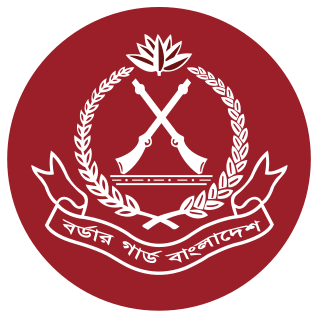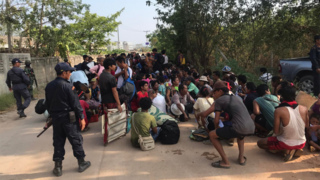
The Border Security Force (BSF) is a central armed police force in India under the Ministry of Home Affairs. It is responsible for guarding India’s borders with Pakistan and Bangladesh. It was formed in the wake of the Indo-Pakistani War of 1965 to ensure the security of India’s borders and for related matters.

The Border Guard Bangladesh (BGB) is a paramilitary force responsible for the border security of Bangladesh. The BGB is entrusted with the responsibility to defend the 4,427 kilometres (2,751 mi) border of Bangladesh with India and Myanmar. It was formerly known as the Bangladesh Rifles (BDR).

Bangladesh–India relations are the bilateral relations between the People's Republic of Bangladesh and the Republic of India, both of which are South Asian neighbours. Diplomatic relations between the two countries formally began in 1971 with India's recognition of an independent Bangladesh following India's military intervention helping Bangladesh secure independence following the Bangladesh Liberation War. On 6 December, Bangladesh and India celebrate Friendship Day commemorating India's recognition of Bangladesh and the continued friendship between the two countries.

The 2001 Bangladesh–India border clashes were a series of armed skirmishes between India and Bangladesh in April 2001. The clashes took place between troops of the Bangladesh Rifles (BDR) and the Indian Border Security Force (BSF) on the poorly-marked international border between the two countries.

A series of occasional armed skirmishes and firefights have occurred along the Afghanistan–Pakistan border between the Afghan Armed Forces and the Pakistan Armed Forces since 1949. The latest round of hostilities between the two countries began in April 2007. Militants belonging to Tehrik-i-Taliban Pakistan and Jamaat-ul-Ahrar also use Afghanistan's territory to target Pakistani security personnel deployed along the border. The Diplomat says that the presence of terrorists belonging to Tehrik-i-Taliban Pakistan on Afghan soil is the reason for sporadic shelling of Afghanistan's territory by Pakistani security forces.

The Bangladesh–India border, known locally as the Radcliffe line (IB), is an international border running between the republics of Bangladesh and India that demarcates the six divisions of Bangladesh and the Indian states.
This is a timeline of the 1967–present Naxalite–Maoist insurgency in eastern India.

The Bangladesh–Myanmar relations refer to the bilateral relationship between Bangladesh and Myanmar. The relationship between these two neighbouring countries is generally frosty under the Burmese military junta, and as a result of the presence of over 270,000 Rohingya refugees in Bangladesh. The civil society and political class of Bangladesh often voiced solidarity for Myanmar's pro-democracy struggle. However, relations between the two nations soured as a result of Rohingya genocide which resulted in the influx of over 1.1 million Rohingya refugees from Rakhine State in Myanmar to Bangladesh. Despite being neighbouring countries, very little trade exists among these countries.
Colonel (Retd.) Sahibzada Shahid Sarwar Azam FIEB is the current head of the Singranatore family.

The 2013 India–Pakistan border incidents was a series of armed skirmishes along the Line of Control (LoC) in the disputed Kashmir area. Starting from the mid-January 2013, they have been described as the "worst bout of fighting in the region in nearly 10 years". It began on 6 January 2013, when according to Pakistani reports Indian forces attacked a Pakistani border post, killing one soldier. Indian authorities claimed the incident as a retaliation against preceding Pakistani ceasefire violations, but denied having crossed the demarcation line. In a second skirmish on 8 January, Indian authorities said that Pakistani forces crossed the LoC, killing two Indian soldiers. The incident sparked outrage in India and harsh reactions by the Indian army and government over the news that the body of one of the soldiers had been beheaded. Pakistan denied these reports. On 15 January, a third skirmish reportedly led to the death of another Pakistani soldier.

The 2014–2015 India–Pakistan border skirmishes were a series of armed clashes and exchanges of gunfire between the Indian Border Security Force and the Pakistan Rangers: the paramilitary gendarmerie forces of both nations, responsible for patrolling the India-Pakistan border) along the Line of Control (LoC) in the disputed Kashmir region and the borders of the Punjab. Tensions began in mid-July 2014, with both countries' military officials and media reports giving different accounts of the incidents and accusing each other of initiating the hostilities. The incident sparked outrage in both countries and harsh reactions by the Indian and Pakistani militaries and the Indian and Pakistani governments.

The Petrapole-Benapole joint retreat ceremony was inaugurated on 6 November 2013 by the Indian Home Minister at Integrated Check Post (ICP) Petrapole-Benapole in the presence of the Home Minister of Bangladesh. It is a daily military exercise, similar to the Wagah Border ceremony, and engages soldiers of Border Security Force (India) and the Border Guards Bangladesh.
Deaths along the Bangladesh–India border occur many times a year as result of people attempting to illegally cross into India from Bangladesh, for walking along the border, cross border firing and cattle smuggling. Bangladesh and India share a 4,096 kilometer border. To prevent smuggling and illegal migration from Bangladesh, the Indian Border Security Force exercises its controversial "Shoot-on-sight" policy. Under this policy, the BSF can shoot any person on site with or without cause. A large portion of the victims are cattle traders and farmers with land near the border. Brad Adams, stated that, "Routinely shooting poor, unarmed villagers is not how the world's largest democracy should behave."

The 2016–2018 India–Pakistan border skirmishes were a series of armed clashes between India and Pakistan, mostly consisting of heavy exchanges of gunfire between Indian and Pakistani forces across the de facto border, known as the Line of Control (LoC), between the two states in the disputed region of Kashmir. The skirmishes began after India claimed to have conducted surgical strikes against militant launch pads within the Pakistani-administered territory of Azad Jammu and Kashmir on 29 September 2016.
The 2015 Bangladesh–Arakan Army border clash took place between 25 August 2015 and 26 August 2015 in the Bandarban District, near the Bangladesh–Myanmar border, after several insurgents of the Arakan Army attacked members of Border Guards Bangladesh.

The Bangladesh–Myanmar border is the international border between the countries of Bangladesh and Myanmar. The border stretches 271.0 kilometres, from the tripoint with India in the north, to the Bay of Bengal in the south. About 210 km (130 mi) of the border is fenced, with the government of Myanmar announcing in 2017 that it was planning to fence off the rest of the border.

On 29 September 2016, teams of Indian Army commandos crossed the Line of Control into Pakistani-administered Kashmir to attack targets up to a kilometer within territory held by Pakistan. The raid occurred ten days after four militants had attacked an Indian army outpost at Uri on 18 September 2016 in the Indian state of Jammu and Kashmir, and killed 19 soldiers. Estimates of casualties from India's cross-border attack varied widely, with figures of 12 to 70 being reported. The Pakistani government eventually acknowledged the deaths of two soldiers and injuries to nine, while one Indian soldier was captured.

The ongoing Myanmar civil war has had an impact on neighbouring countries. Refugees and junta officials have fled into Bangladesh, India and Thailand. Territorial violations of Bangladeshi territory, such as artillery strikes and firing at vessels near St. Martin's Island, have caused border tensions. In India, the conflict also contributed to the 2023–2024 Manipur violence.
The 1979 Bangladesh-India skirmishes was a incident of border firing between Bangladesh and India from November to December 1979. The border firing took place between troops of the Bangladesh Rifles (BDR) and the Border Security Force (BSF) on the poorly-marked international border between the two countries.










